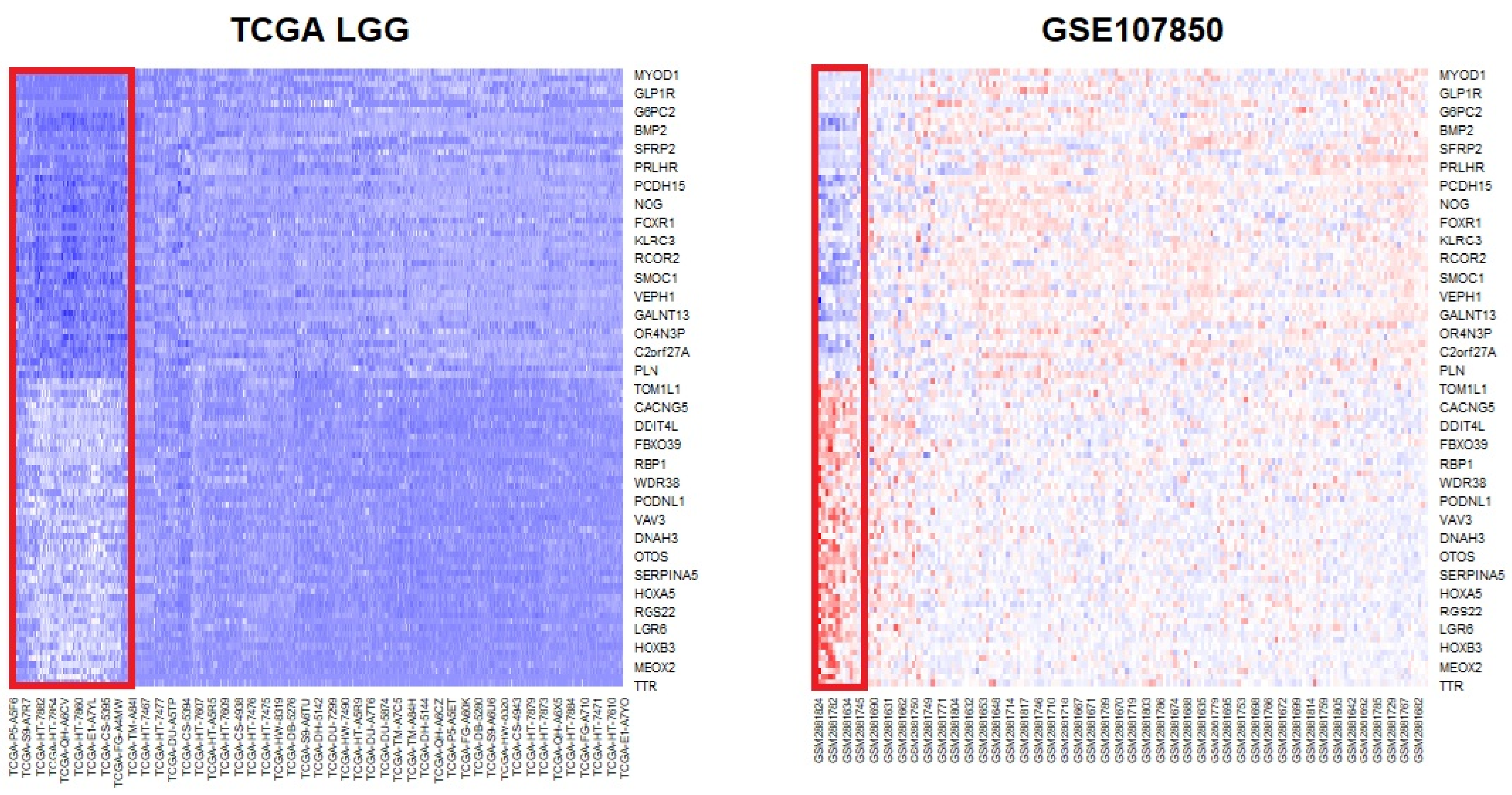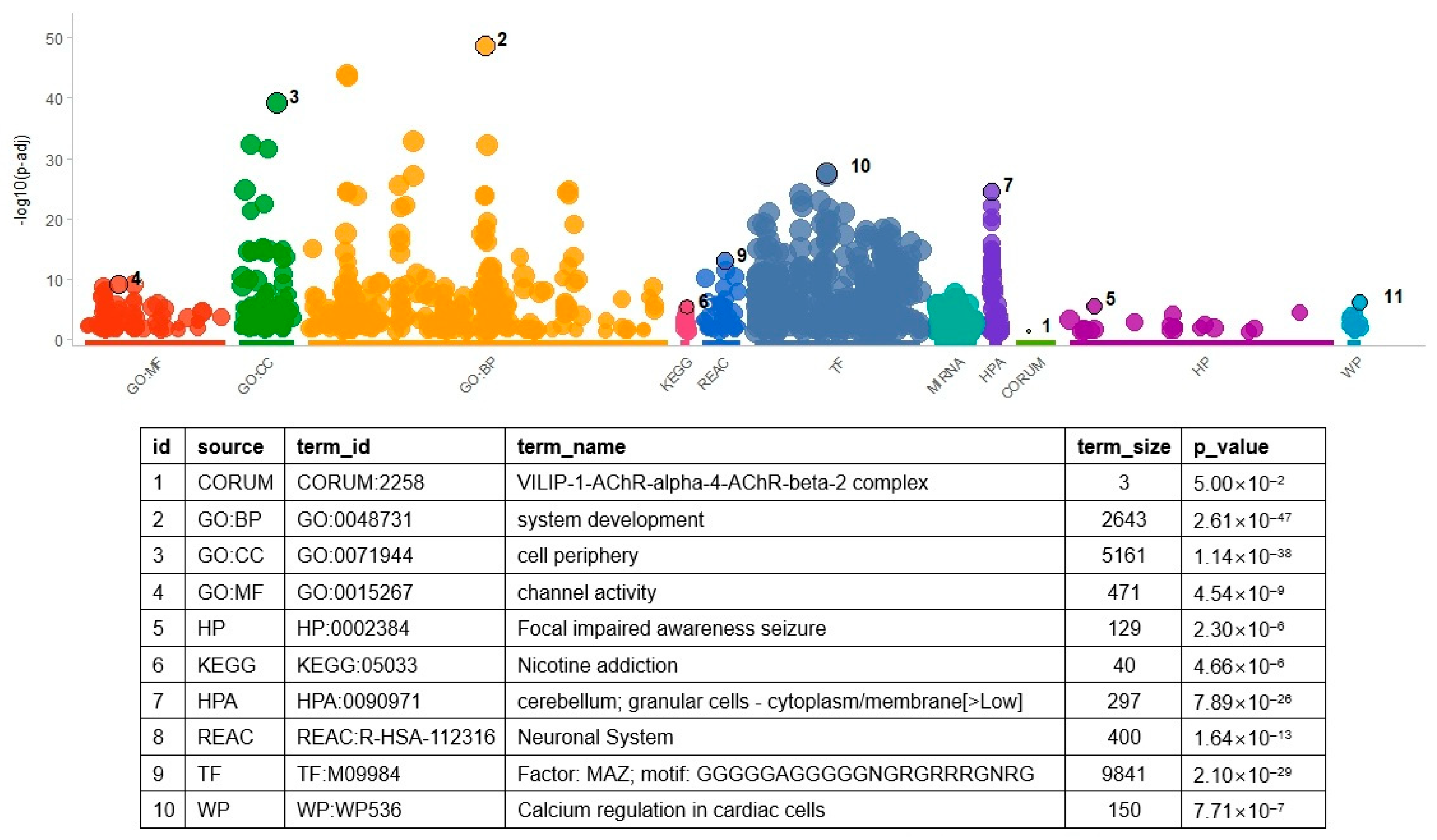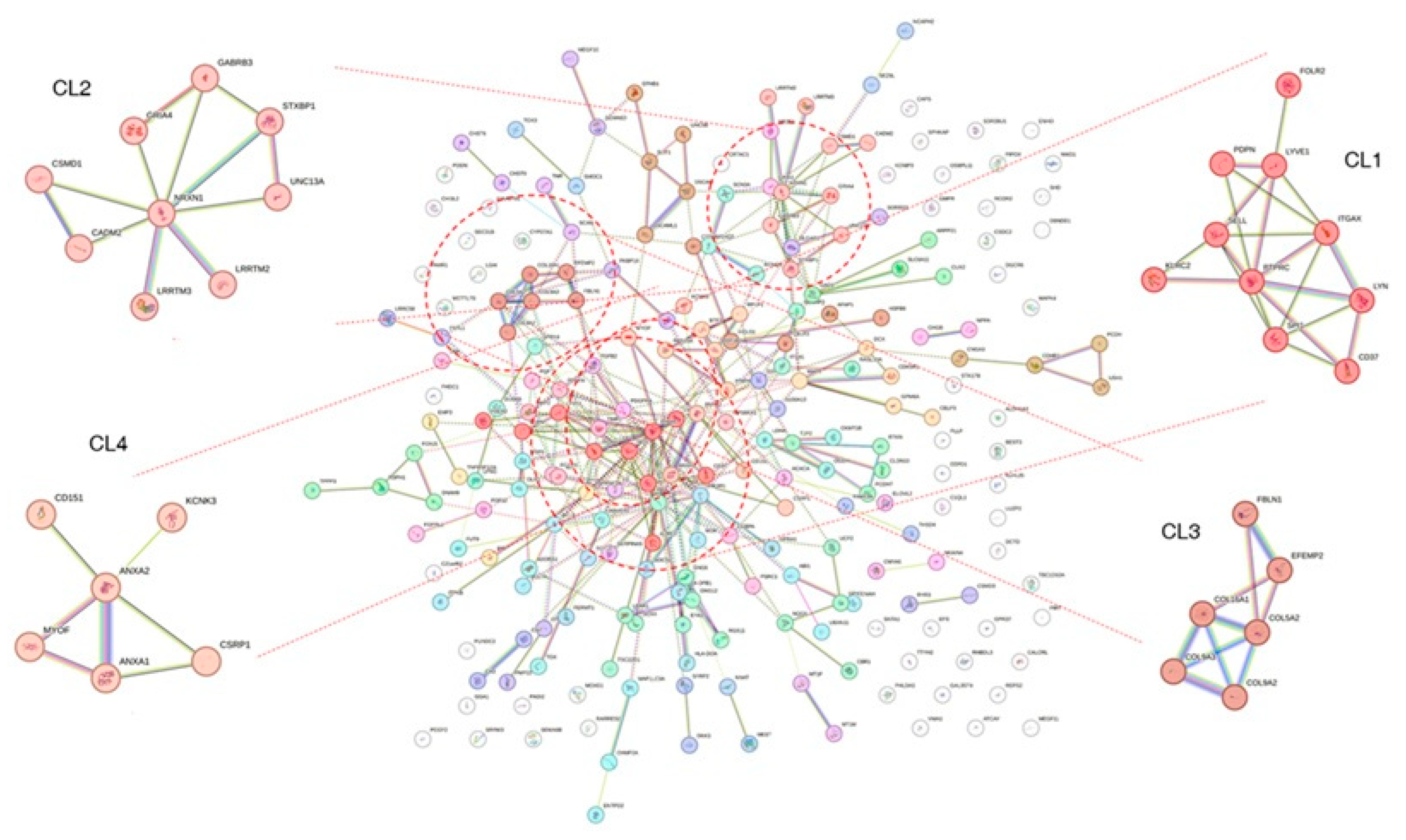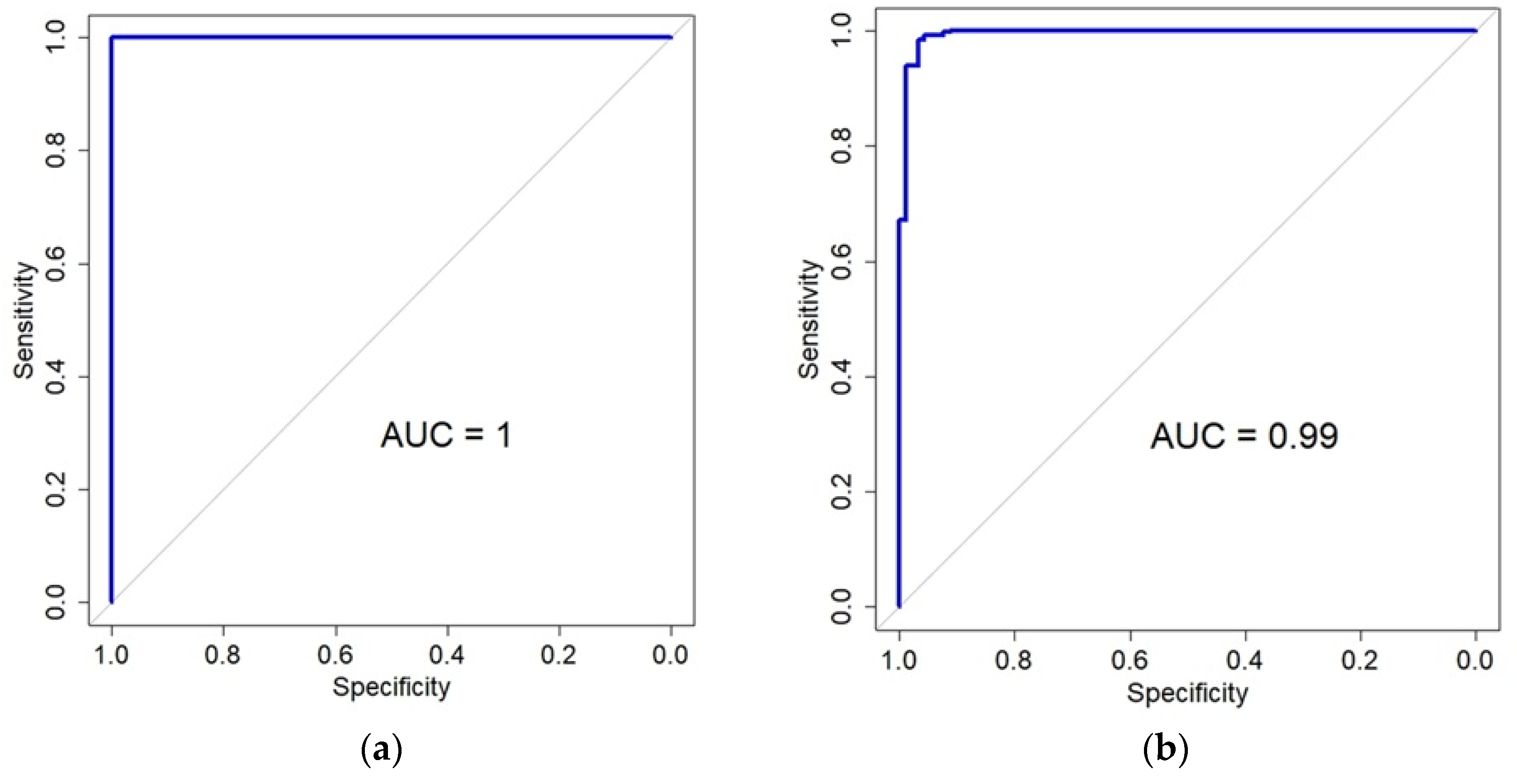Transcriptomic Profile of Isocitrate Dehydrogenase Mutant Type of Lower-Grade Glioma Reveals Molecular Changes for Prognosis
Abstract
1. Introduction
2. Materials and Methods
2.1. Differentially Expressed Gene Analysis
2.2. Differential Coexpression of Gene Pairs Between IDH Status
2.3. Gene Set Enrichment Analysis Using Gprofiler2
2.4. Network-Based Clustering of Genes with Protein-Protein Interaction Network
2.5. Drug Repurposing Analysis with L1000 Data and CLUE Platform
3. Results
3.1. Lower-Grade Glioma Data from Public Databases
3.2. Differential Expression Between IDH Status Groups
3.3. Significant Change of Co-Expressed Gene Pairs Between IDH Status
3.4. Clustering of Differentially Expressed and Co-Expressed Genes with Protein-Protein Interaction (PPI) Network
3.5. Prediction of IDH Status Using Transcriptomics Data
3.6. Drug Repurposing Analysis Using CLUE Platform
4. Discussion
5. Conclusions
Supplementary Materials
Funding
Institutional Review Board Statement
Informed Consent Statement
Data Availability Statement
Conflicts of Interest
References
- Zhang, Y.; Liu, Y.; Lang, F.; Yang, C. IDH mutation and cancer stem cell. Essays Biochem. 2022, 66, 413–422. [Google Scholar] [CrossRef]
- Youssef, G.; Miller, J.J. Lower Grade Gliomas. Curr. Neurol. Neurosci. Rep. 2020, 20, 21. [Google Scholar] [CrossRef]
- Fried, I.; Tabori, U.; Tihan, T.; Reginald, A.; Bouffet, E. Optic pathway gliomas: A review. CNS Oncol. 2013, 2, 143–159. [Google Scholar] [CrossRef]
- Evans, L.; Trinder, S.; Dodgshun, A.; Eisenstat, D.D.; Whittle, J.R.; Hansford, J.R.; Valvi, S. IDH-mutant gliomas in children and adolescents—From biology to clinical trials. Front. Oncol. 2024, 14, 1515538. [Google Scholar] [CrossRef] [PubMed]
- De Simone, M.; Choucha, A.; Ranalli, C.; Pecoraro, G.; Appay, R.; Chinot, O.L.; Dufour, H.; Iaconetta, G. Astrocytomas IDH-mutant of posterior cranial fossa, clinical presentation, imaging features and onco-functional balance in surgical management. Neurosurg. Rev. 2025, 48, 271. [Google Scholar] [CrossRef] [PubMed]
- Han, S.; Liu, Y.; Cai, S.J.; Qian, M.; Ding, J.; Larion, M.; Gilbert, M.R.; Yang, C. IDH mutation in glioma: Molecular mechanisms and potential therapeutic targets. Br. J. Cancer 2020, 122, 1580–1589. [Google Scholar] [CrossRef] [PubMed]
- Xiang, X.; Liu, Z.; Zhang, C.; Li, Z.; Gao, J.; Zhang, C.; Cao, Q.; Cheng, J.; Liu, H.; Chen, D.; et al. IDH Mutation Subgroup Status Associates with Intratumor Heterogeneity and the Tumor Microenvironment in Intrahepatic Cholangiocarcinoma. Adv. Sci. (Weinh) 2021, 8, e2101230. [Google Scholar] [CrossRef]
- Raineri, S.; Mellor, J. IDH1: Linking Metabolism and Epigenetics. Front. Genet. 2018, 9, 493. [Google Scholar] [CrossRef]
- Park, J.W.; Turcan, S. Epigenetic Reprogramming for Targeting IDH-Mutant Malignant Gliomas. Cancers 2019, 11, 1616. [Google Scholar] [CrossRef]
- Unruh, D.; Zewde, M.; Buss, A.; Drumm, M.R.; Tran, A.N.; Scholtens, D.M.; Horbinski, C. Methylation and transcription patterns are distinct in IDH mutant gliomas compared to other IDH mutant cancers. Sci. Rep. 2019, 9, 8946. [Google Scholar] [CrossRef]
- Mo, H.; Magaki, S.; Deisch, J.K.; Raghavan, R. Isocitrate Dehydrogenase Mutations Are Associated with Different Expression and DNA Methylation Patterns of OLIG2 in Adult Gliomas. J. Neuropathol. Exp. Neurol. 2022, 81, 707–716. [Google Scholar] [CrossRef]
- Brat, D.J.; Aldape, K.; Colman, H.; Holland, E.C.; Louis, D.N.; Jenkins, R.B.; Kleinschmidt-DeMasters, B.K.; Perry, A.; Reifenberger, G.; Stupp, R.; et al. cIMPACT-NOW update 3: Recommended diagnostic criteria for “Diffuse astrocytic glioma, IDH-wildtype, with molecular features of glioblastoma, WHO grade IV”. Acta Neuropathol. 2018, 136, 805–810. [Google Scholar] [CrossRef]
- Wu, C.; Song, H.; Fu, X.; Li, S.; Jiang, T. Transcriptomic Analysis of Glioma Based on IDH Status Identifies ACAA2 as a Prognostic Factor in Lower Grade Glioma. Biomed. Res. Int. 2020, 2020, 1086792. [Google Scholar] [CrossRef]
- Li, T.; Yang, Z.; Li, H.; Zhu, J.; Wang, Y.; Tang, Q.; Shi, Z. Phospholipase Cgamma1 (PLCG1) overexpression is associated with tumor growth and poor survival in IDH wild-type lower-grade gliomas in adult patients. Lab. Investig. 2022, 102, 143–153. [Google Scholar] [CrossRef]
- Cai, J.; Hu, Y.; Ye, Z.; Ye, L.; Gao, L.; Wang, Y.; Sun, Q.; Tong, S.; Yang, J.; Chen, Q. Immunogenic cell death-related risk signature predicts prognosis and characterizes the tumour microenvironment in lower-grade glioma. Front. Immunol. 2022, 13, 1011757. [Google Scholar] [CrossRef]
- Ceccarelli, M.; Barthel, F.P.; Malta, T.M.; Sabedot, T.S.; Salama, S.R.; Murray, B.A.; Morozova, O.; Newton, Y.; Radenbaugh, A.; Pagnotta, S.M.; et al. Molecular Profiling Reveals Biologically Discrete Subsets and Pathways of Progression in Diffuse Glioma. Cell 2016, 164, 550–563. [Google Scholar] [CrossRef]
- Gao, Y.; Weenink, B.; van den Bent, M.J.; Erdem-Eraslan, L.; Kros, J.M.; Sillevis Smitt, P.; Hoang-Xuan, K.; Brandes, A.A.; Vos, M.; Dhermain, F.; et al. Expression-based intrinsic glioma subtypes are prognostic in low-grade gliomas of the EORTC22033-26033 clinical trial. Eur. J. Cancer 2018, 94, 168–178. [Google Scholar] [CrossRef]
- Kolberg, L.; Raudvere, U.; Kuzmin, I.; Vilo, J.; Peterson, H. gprofiler2—An R package for gene list functional enrichment analysis and namespace conversion toolset g:Profiler. F1000Research 2020, 9. [Google Scholar] [CrossRef] [PubMed]
- Harris, M.A.; Clark, J.; Ireland, A.; Lomax, J.; Ashburner, M.; Foulger, R.; Eilbeck, K.; Lewis, S.; Marshall, B.; Mungall, C.; et al. The Gene Ontology (GO) database and informatics resource. Nucleic Acids Res. 2004, 32, D258–D261. [Google Scholar] [CrossRef] [PubMed]
- Kanehisa, M.; Goto, S.; Sato, Y.; Furumichi, M.; Tanabe, M. KEGG for integration and interpretation of large-scale molecular data sets. Nucleic Acids Res. 2012, 40, D109–D114. [Google Scholar] [CrossRef] [PubMed]
- Milacic, M.; Beavers, D.; Conley, P.; Gong, C.; Gillespie, M.; Griss, J.; Haw, R.; Jassal, B.; Matthews, L.; May, B.; et al. The Reactome Pathway Knowledgebase 2024. Nucleic Acids Res. 2024, 52, D672–D678. [Google Scholar] [CrossRef]
- Agrawal, A.; Balci, H.; Hanspers, K.; Coort, S.L.; Martens, M.; Slenter, D.N.; Ehrhart, F.; Digles, D.; Waagmeester, A.; Wassink, I.; et al. WikiPathways 2024: Next generation pathway database. Nucleic Acids Res. 2024, 52, D679–D689. [Google Scholar] [CrossRef] [PubMed]
- Gargano, M.A.; Matentzoglu, N.; Coleman, B.; Addo-Lartey, E.B.; Anagnostopoulos, A.V.; Anderton, J.; Avillach, P.; Bagley, A.M.; Bakstein, E.; Balhoff, J.P.; et al. The Human Phenotype Ontology in 2024: Phenotypes around the world. Nucleic Acids Res. 2024, 52, D1333–D1346. [Google Scholar] [CrossRef] [PubMed]
- Szklarczyk, D.; Kirsch, R.; Koutrouli, M.; Nastou, K.; Mehryary, F.; Hachilif, R.; Gable, A.L.; Fang, T.; Doncheva, N.T.; Pyysalo, S.; et al. The STRING database in 2023: Protein-protein association networks and functional enrichment analyses for any sequenced genome of interest. Nucleic Acids Res. 2023, 51, D638–D646. [Google Scholar] [CrossRef]
- Musa, A.; Ghoraie, L.S.; Zhang, S.D.; Glazko, G.; Yli-Harja, O.; Dehmer, M.; Haibe-Kains, B.; Emmert-Streib, F. A review of connectivity map and computational approaches in pharmacogenomics. Brief. Bioinform. 2018, 19, 506–523. [Google Scholar] [CrossRef]
- Subramanian, A.; Narayan, R.; Corsello, S.M.; Peck, D.D.; Natoli, T.E.; Lu, X.; Gould, J.; Davis, J.F.; Tubelli, A.A.; Asiedu, J.K.; et al. A Next Generation Connectivity Map: L1000 Platform and the First 1,000,000 Profiles. Cell 2017, 171, 1437–1452 e1417. [Google Scholar] [CrossRef]
- Gao, J.; Aksoy, B.A.; Dogrusoz, U.; Dresdner, G.; Gross, B.; Sumer, S.O.; Sun, Y.; Jacobsen, A.; Sinha, R.; Larsson, E.; et al. Integrative analysis of complex cancer genomics and clinical profiles using the cBioPortal. Sci. Signal. 2013, 6, pl1. [Google Scholar] [CrossRef]
- Hutter, C.; Zenklusen, J.C. The Cancer Genome Atlas: Creating Lasting Value beyond Its Data. Cell 2018, 173, 283–285. [Google Scholar] [CrossRef] [PubMed]
- Li, B.; Dewey, C.N. RSEM: Accurate transcript quantification from RNA-Seq data with or without a reference genome. BMC Bioinform. 2011, 12, 323. [Google Scholar] [CrossRef]
- IlluminaHumanv4.db: Illumina HumanHT12v4 Annotation Data (Chip illuminaHumanv4). Available online: https://bioconductor.org/packages/release/data/annotation/html/illuminaHumanv4.db.html (accessed on 12 May 2025).
- Cancer Genome Atlas Research, N.; Brat, D.J.; Verhaak, R.G.; Aldape, K.D.; Yung, W.K.; Salama, S.R.; Cooper, L.A.; Rheinbay, E.; Miller, C.R.; Vitucci, M.; et al. Comprehensive, Integrative Genomic Analysis of Diffuse Lower-Grade Gliomas. N. Engl. J. Med. 2015, 372, 2481–2498. [Google Scholar] [CrossRef]
- Tibshirani, R. Regression Shrinkage and Selection Via the Lasso. J. R. Stat. Soc.Ser. B (Methodol.) 1996, 58, 267–288. [Google Scholar]
- Li, Y.; Ge, X.; Peng, F.; Li, W.; Li, J.J. Exaggerated false positives by popular differential expression methods when analyzing human population samples. Genome Biol. 2022, 23, 79. [Google Scholar] [CrossRef]
- Uhlmann, K.; Rohde, K.; Zeller, C.; Szymas, J.; Vogel, S.; Marczinek, K.; Thiel, G.; Nurnberg, P.; Laird, P.W. Distinct methylation profiles of glioma subtypes. Int. J. Cancer 2003, 106, 52–59. [Google Scholar] [CrossRef]
- Ren, P.; Wang, J.Y.; Zeng, Z.R.; Li, N.X.; Chen, H.L.; Peng, X.G.; Bhawal, U.K.; Guo, W.Z. A novel hypoxia-driven gene signature that can predict the prognosis and drug resistance of gliomas. Front. Genet. 2022, 13, 976356. [Google Scholar] [CrossRef] [PubMed]
- Ren, P.; Wang, J.; Li, L.; Lin, X.; Wu, G.; Chen, J.; Zeng, Z.; Zhang, H. Identification of key genes involved in the recurrence of glioblastoma multiforme using weighted gene co-expression network analysis and differential expression analysis. Bioengineered 2021, 12, 3188–3200. [Google Scholar] [CrossRef] [PubMed]
- Davis, F.B.; Tang, H.Y.; Shih, A.; Keating, T.; Lansing, L.; Hercbergs, A.; Fenstermaker, R.A.; Mousa, A.; Mousa, S.A.; Davis, P.J.; et al. Acting via a cell surface receptor, thyroid hormone is a growth factor for glioma cells. Cancer Res. 2006, 66, 7270–7275. [Google Scholar] [CrossRef]
- Yao, Q.; Cai, G.; Yu, Q.; Shen, J.; Gu, Z.; Chen, J.; Shi, W.; Shi, J. IDH1 mutation diminishes aggressive phenotype in glioma stem cells. Int. J. Oncol. 2018, 52, 270–278. [Google Scholar] [CrossRef]
- Haddock, S.; Alban, T.J.; Turcan, S.; Husic, H.; Rosiek, E.; Ma, X.; Wang, Y.; Bale, T.; Desrichard, A.; Makarov, V.; et al. Phenotypic and molecular states of IDH1 mutation-induced CD24-positive glioma stem-like cells. Neoplasia 2022, 28, 100790. [Google Scholar] [CrossRef]
- Olszewski, M.; Huang, W.; Chou, P.M.; Duerst, R.; Kletzel, M. Wilms’ tumor 1 (WT1) gene in hematopoiesis: A surrogate marker of cell proliferation as a possible mechanism of action? Cytotherapy 2005, 7, 57–61. [Google Scholar] [CrossRef]
- Felthaus, O.; Viale-Bouroncle, S.; Driemel, O.; Reichert, T.E.; Schmalz, G.; Morsczeck, C. Transcription factors TP53 and SP1 and the osteogenic differentiation of dental stem cells. Differentiation 2012, 83, 10–16. [Google Scholar] [CrossRef]
- Guetta-Terrier, C.; Karambizi, D.; Akosman, B.; Zepecki, J.P.; Chen, J.S.; Kamle, S.; Fajardo, J.E.; Fiser, A.; Singh, R.; Toms, S.A.; et al. Chi3l1 Is a Modulator of Glioma Stem Cell States and a Therapeutic Target in Glioblastoma. Cancer Res. 2023, 83, 1984–1999. [Google Scholar] [CrossRef] [PubMed]
- Loh, J.J.; Ma, S. Hallmarks of cancer stemness. Cell Stem Cell 2024, 31, 617–639. [Google Scholar] [CrossRef]
- Xu, X.; Hou, Y.; Long, N.; Jiang, L.; Yan, Z.; Xu, Y.; Lv, Y.; Xiang, X.; Yang, H.; Liu, J.; et al. TPPP3 promote epithelial-mesenchymal transition via Snail1 in glioblastoma. Sci. Rep. 2023, 13, 17960. [Google Scholar] [CrossRef] [PubMed]
- Sakamoto, S.; Inoue, H.; Takino, T.; Kohda, Y.; Yoshida, J.; Ohba, S.; Usami, I.; Suzuki, T.; Kawada, M.; Hatakeyama, M. Claudin-11 Enhances Invasive and Metastatic Abilities of Small-Cell Lung Cancer Through MT1-MMP Activation. Cancer Sci. 2025, 116, 1773–1784. [Google Scholar] [CrossRef]
- Dmytrenko, V.V.; Boiko, O.I.; Shostak, K.O.; Bilets’kyi, A.V.; Malysheva, T.A.; Shamaiev, M.I.; Kliuchka, V.M.; Rozumenko, V.D.; Zozulia Iu, P.; Kavsan, V.M. Expression of myelin basic protein and glial fibrillary acidic protein genes in human glial brain tumors. Tsitol. Genet. 2009, 43, 28–35. [Google Scholar]
- Liu, Y.; Lu, Y.; Li, A.; Celiku, O.; Han, S.; Qian, M.; Yang, C. mTORC2/Rac1 Pathway Predisposes Cancer Aggressiveness in IDH1-Mutated Glioma. Cancers 2020, 12, 787. [Google Scholar] [CrossRef]
- Gong, P.; Chen, S.; Zhang, L.; Hu, Y.; Gu, A.; Zhang, J.; Wang, Y. RhoG-ELMO1-RAC1 is involved in phagocytosis suppressed by mono-butyl phthalate in TM4 cells. Environ. Sci. Pollut. Res. Int. 2018, 25, 35440–35450. [Google Scholar] [CrossRef]
- Mohiuddin, E.; Wakimoto, H. Extracellular matrix in glioblastoma: Opportunities for emerging therapeutic approaches. Am. J. Cancer Res. 2021, 11, 3742–3754. [Google Scholar]
- Hattermann, K.; Fluh, C.; Engel, D.; Mehdorn, H.M.; Synowitz, M.; Mentlein, R.; Held-Feindt, J. Stem cell markers in glioma progression and recurrence. Int. J. Oncol. 2016, 49, 1899–1910. [Google Scholar] [CrossRef] [PubMed]
- Mahdi, A.; Aittaleb, M.; Tissir, F. Targeting Glioma Stem Cells: Therapeutic Opportunities and Challenges. Cells 2025, 14, 675. [Google Scholar] [CrossRef]
- Ma, B.; Zhang, L.; Zou, Y.; He, R.; Wu, Q.; Han, C.; Zhang, B. Reciprocal regulation of integrin beta4 and KLF4 promotes gliomagenesis through maintaining cancer stem cell traits. J. Exp. Clin. Cancer Res. 2019, 38, 23. [Google Scholar] [CrossRef]
- Xie, P.; Zhang, Y.; Chen, R.; Zheng, J.; Cui, G. PTBP3 promotes tumorigenesis of glioblastoma by stabilizing Twist1. Transl. Oncol. 2022, 25, 101520. [Google Scholar] [CrossRef]
- Fang, J.; Jia, J.; Makowski, M.; Xu, M.; Wang, Z.; Zhang, T.; Hoskins, J.W.; Choi, J.; Han, Y.; Zhang, M.; et al. Functional characterization of a multi-cancer risk locus on chr5p15.33 reveals regulation of TERT by ZNF148. Nat. Commun. 2017, 8, 15034. [Google Scholar] [CrossRef] [PubMed]
- Chua, B.H.; Zaal Anuar, N.; Ferry, L.; Domrane, C.; Wittek, A.; Mukundan, V.T.; Jha, S.; Butter, F.; Tenen, D.G.; Defossez, P.A.; et al. E4F1 and ZNF148 are transcriptional activators of the -57A > C and wild-type TERT promoter. Genome. Res. 2023, 33, 1893–1905. [Google Scholar] [CrossRef]
- Cheng, S.; Liu, L.; Wang, D.; Li, Y.; Li, S.; Yuan, J.; Huang, S.; Xu, Z.; Jia, B.; Li, Z.; et al. Upregulation of the ZNF148/PTX3 axis promotes malignant transformation of dendritic cells in glioma stem-like cells microenvironment. CNS Neurosci. Ther. 2023, 29, 2690–2704. [Google Scholar] [CrossRef]
- Gao, X.; Ma, C.; Sun, X.; Zhao, Q.; Fang, Y.; Jiang, Y.; Shen, K.; Shen, X. Upregulation of ZNF148 in SDHB-deficient gastrointestinal stromal tumor potentiates Forkhead box M1-mediated transcription and promotes tumor cell invasion. Cancer Sci. 2020, 111, 1266–1278. [Google Scholar] [CrossRef] [PubMed]
- Olympios, N.; Gilard, V.; Marguet, F.; Clatot, F.; Di Fiore, F.; Fontanilles, M. TERT Promoter Alterations in Glioblastoma: A Systematic Review. Cancers 2021, 13, 1147. [Google Scholar] [CrossRef]
- Fan, X.; Li, Y.; Shan, X.; You, G.; Wu, Z.; Li, Z.; Qiao, H.; Jiang, T. Seizures at presentation are correlated with better survival outcomes in adult diffuse glioma: A systematic review and meta-analysis. Seizure 2018, 59, 16–23. [Google Scholar] [CrossRef] [PubMed]
- Lin, H.; Yang, Y.; Hou, C.; Huang, Y.; Zhou, L.; Zheng, J.; Lv, G.; Mao, R.; Chen, S.; Xu, P.; et al. Validation of the functions and prognostic values of synapse-associated proteins in lower-grade glioma. Biosci. Rep. 2021, 41. [Google Scholar] [CrossRef]
- Gu, W.; Brodtkorb, E.; Piepoli, T.; Finocchiaro, G.; Steinlein, O.K. LGI1: A gene involved in epileptogenesis and glioma progression? Neurogenetics 2005, 6, 59–66. [Google Scholar] [CrossRef]
- Xie, M.; Wang, X.; Duan, Z.; Luan, G. Low-grade epilepsy-associated neuroepithelial tumors: Tumor spectrum and diagnosis based on genetic alterations. Front. Neurosci. 2022, 16, 1071314. [Google Scholar] [CrossRef] [PubMed]
- Du, B.; Gao, W.; Qin, Y.; Zhong, J.; Zhang, Z. Study on the role of transcription factor SPI1 in the development of glioma. Chin. Neurosurg. J. 2022, 8, 7. [Google Scholar] [CrossRef] [PubMed]
- Song, Y.; Zhang, Y.; Wang, X.; Han, X.; Shi, M.; Xu, L.; Yu, J.; Zhang, L.; Han, S. SPI1 activates TGF-beta1/PI3K/Akt signaling through transcriptional upregulation of FKBP12 to support the mesenchymal phenotype of glioma stem cells. Brain Pathol. 2024, 34, e13217. [Google Scholar] [CrossRef]
- Yan, X.; Zhou, Q.; Zhu, H.; Liu, W.; Xu, H.; Yin, W.; Zhao, M.; Jiang, X.; Ren, C. The clinical features, prognostic significance, and immune heterogeneity of CD37 in diffuse gliomas. iScience 2021, 24, 103249. [Google Scholar] [CrossRef]
- Badalotti, R.; Dalmolin, M.; Malafaia, O.; Ribas Filho, J.M.; Roesler, R.; Fernandes, M.A.C.; Isolan, G.R. Gene Expression of GABA(A) Receptor Subunits and Association with Patient Survival in Glioma. Brain Sci. 2024, 14, 275. [Google Scholar] [CrossRef]
- Barbosa, L.C.; Machado, G.C.; Heringer, M.; Ferrer, V.P. Identification of established and novel extracellular matrix components in glioblastoma as targets for angiogenesis and prognosis. Neurogenetics 2024, 25, 249–262. [Google Scholar] [CrossRef]
- Cheng, X.; Liu, Z.; Liang, W.; Zhu, Q.; Wang, C.; Wang, H.; Zhang, J.; Li, P.; Gao, Y. ECM2, a prognostic biomarker for lower grade glioma, serves as a potential novel target for immunotherapy. Int. J. Biochem. Cell Biol. 2023, 158, 106409. [Google Scholar] [CrossRef]
- Li, Y.; Ye, X.; Liu, J.; Zha, J.; Pei, L. Evaluation of EML4-ALK fusion proteins in non-small cell lung cancer using small molecule inhibitors. Neoplasia 2011, 13, 1–11. [Google Scholar] [CrossRef]
- Lorente, M.; Torres, S.; Salazar, M.; Carracedo, A.; Hernandez-Tiedra, S.; Rodriguez-Fornes, F.; Garcia-Taboada, E.; Melendez, B.; Mollejo, M.; Campos-Martin, Y.; et al. Stimulation of the midkine/ALK axis renders glioma cells resistant to cannabinoid antitumoral action. Cell Death Differ. 2011, 18, 959–973. [Google Scholar] [CrossRef]
- Kawauchi, D.; Takahashi, M.; Satomi, K.; Yamamuro, S.; Kobayashi, T.; Uchida, E.; Honda-Kitahara, M.; Narita, Y.; Iwadate, Y.; Ichimura, K.; et al. The ALK inhibitors, alectinib and ceritinib, induce ALK-independent and STAT3-dependent glioblastoma cell death. Cancer Sci. 2021, 112, 2442–2453. [Google Scholar] [CrossRef] [PubMed]
- Tsai, C.C.; Huang, M.H.; Fang, C.L.; Hsieh, K.L.; Hsieh, T.H.; Ho, W.L.; Chang, H.; Tsai, M.L.; Kao, Y.C.; Miser, J.S.; et al. An Infant-Type Hemispheric Glioma With SOX5::ALK: A Novel Fusion. J. Natl. Compr. Canc. Netw. 2024, 22. [Google Scholar] [CrossRef] [PubMed]
- Kim, J.H. Prognostic and predictive markers in glioblastoma and ALK overexpression. J. Pathol. Transl. Med. 2021, 55, 236–237. [Google Scholar] [CrossRef]
- Morreale, A.; Mallon, B.; Beale, G.; Watson, J.; Rumsby, M. Ro31-8220 inhibits protein kinase C to block the phorbol ester-stimulated release of choline- and ethanolamine-metabolites from C6 glioma cells: p70 S6 kinase and MAPKAP kinase-1beta do not function downstream of PKC in activating PLD. FEBS Lett. 1997, 417, 38–42. [Google Scholar] [CrossRef] [PubMed]
- Wick, W.; Puduvalli, V.K.; Chamberlain, M.C.; van den Bent, M.J.; Carpentier, A.F.; Cher, L.M.; Mason, W.; Weller, M.; Hong, S.; Musib, L.; et al. Phase III study of enzastaurin compared with lomustine in the treatment of recurrent intracranial glioblastoma. J. Clin. Oncol. 2010, 28, 1168–1174. [Google Scholar] [CrossRef] [PubMed]





| TCGA | GSE107850 | |||||||
|---|---|---|---|---|---|---|---|---|
| Gene Pair | IDHwt | IDHmut | Pval | ID1 | ID2 | IDHwt | IDHmut | Pval |
| STMN2_SVOP | 0.93 | 0.75 | 7.38 × 10−10 | ILMN_1795679 | ILMN_1764780 | 0.97 | 0.62 | 4.91 × 10−6 |
| STAB1_COL6A3 | 0.79 | 0.26 | 3.65 × 10−12 | ILMN_1655987 | ILMN_2307861 | −0.76 | 0.34 | 1.53 × 10−5 |
| CLDN11_TPPP3 | 0.24 | 0.81 | 5.66 × 10−14 | ILMN_1754103 | ILMN_1797744 | −0.56 | 0.67 | 3.36 × 10−6 |
| PPP2R2C_FGF12 | 0.70 | 0.16 | 1.39 × 10−9 | ILMN_1680507 | ILMN_1672229 | 0.93 | 0.12 | 1.03 × 10−6 |
| CLDN11_DSCAML1 | 0.56 | −0.13 | 6.30 × 10−11 | ILMN_1754103 | ILMN_2075962 | 0.89 | 0.05 | 9.11 × 10−6 |
| STAB1_CFH | 0.78 | 0.29 | 3.98 × 10−10 | ILMN_1655987 | ILMN_1657803 | −0.88 | 0.14 | 1.40 × 10−6 |
| MBP_RNASE1 | 0.30 | 0.79 | 2.61 × 10−11 | ILMN_2331544 | ILMN_2333670 | 0.97 | 0.53 | 3.36 × 10−6 |
| Term ID | Term Description | False Discovery Rate |
|---|---|---|
| GO:0030198 | Extracellular matrix organization | 1.33 × 10−7 |
| GO:0005201 | Extracellular matrix structural constituent | 4.99 × 10−10 |
| GO:0062023 | Collagen-containing extracellular matrix | 1.67 × 10−7 |
| CL:19457 | Extracellular matrix organization | 2.99 × 10−9 |
| hsa04974 | Protein digestion and absorption | 3.66 × 10−6 |
| HSA-1474244 | Extracellular matrix organization | 3.05 × 10−8 |
| WP4789 | MED and pseudoachondroplasia genes | 0.0017 |
| HP:0003272 | Abnormal hip bone morphology | 0.00052 |
| DOID:0070298 | Multiple epiphyseal dysplasia 2 | 0.0035 |
| BTO:0000421 | Connective tissue | 0.0038 |
| GOCC:0005581 | Collagen trimer | 5.01 × 10−7 |
| KW-0176 | Collagen | 1.93 × 10−6 |
| PF01391 | Collagen triple helix repeat (20 copies) | 6.32 × 10−6 |
| IPR008160 | Collagen triple helix repeat | 2.84 × 10−5 |
Disclaimer/Publisher’s Note: The statements, opinions and data contained in all publications are solely those of the individual author(s) and contributor(s) and not of MDPI and/or the editor(s). MDPI and/or the editor(s) disclaim responsibility for any injury to people or property resulting from any ideas, methods, instructions or products referred to in the content. |
© 2025 by the author. Licensee MDPI, Basel, Switzerland. This article is an open access article distributed under the terms and conditions of the Creative Commons Attribution (CC BY) license (https://creativecommons.org/licenses/by/4.0/).
Share and Cite
Cho, S.B. Transcriptomic Profile of Isocitrate Dehydrogenase Mutant Type of Lower-Grade Glioma Reveals Molecular Changes for Prognosis. Biomedicines 2025, 13, 2263. https://doi.org/10.3390/biomedicines13092263
Cho SB. Transcriptomic Profile of Isocitrate Dehydrogenase Mutant Type of Lower-Grade Glioma Reveals Molecular Changes for Prognosis. Biomedicines. 2025; 13(9):2263. https://doi.org/10.3390/biomedicines13092263
Chicago/Turabian StyleCho, Seong Beom. 2025. "Transcriptomic Profile of Isocitrate Dehydrogenase Mutant Type of Lower-Grade Glioma Reveals Molecular Changes for Prognosis" Biomedicines 13, no. 9: 2263. https://doi.org/10.3390/biomedicines13092263
APA StyleCho, S. B. (2025). Transcriptomic Profile of Isocitrate Dehydrogenase Mutant Type of Lower-Grade Glioma Reveals Molecular Changes for Prognosis. Biomedicines, 13(9), 2263. https://doi.org/10.3390/biomedicines13092263






